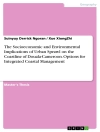This open access book contains texts by the Nobel laureate Paul J. Crutzen who is best known for his research on ozone depletion. It comprises Crutzen’s autobiography, several pictures documenting important stages of his life, and his most important scientific publications. The Dutch atmospheric chemist is one of the world’s most cited scientists in geosciences. His political engagement makes him a tireless ambassador for environmental issues such as climate change. He popularized the term ‘Anthropocene’ for the current geological era acknowledging the enduring influence of humankind on planet Earth. This concept conceives humans to be a geologic factor, influencing the evolution of our globe and the living beings populating it. The selection of texts is representing Paul Crutzen´s scientific oeuvre as his research interests span from ozone depletion to the climatic impacts of biomass burning, the consequences of a worldwide atomic war – the Nuclear Winter – to geoengineering and the Anthropocene.
This book is available open access under a Creative Commons Attribution 4.0 International License via link.springer.com.
表中的内容
The Background of an Ozone Researcher: A Brief Autobiography.- Complete Bibliography of the Writings of Paul J. Crutzen (1965-2014).- The Influence of Nitrogen Oxides on Atmospheric Ozone Content.- Biomass Burning as a Source of Atmospheric Gases CO2, H2, N2O, NO, CH3Cl and COS.- The Atmosphere after a Nuclear War: Twilight at Noon.- Nitric–acid Cloud Formation in the Cold Antarctic Stratosphere – A Major Cause for the Springtime Ozone Hole.- Biomass Burning in the Tropics: Impact on Atmospheric Chemistry and Biogeochemical Cycles.- A Mechanism for Halogen Release from Sea-salt Aerosol in the Remote Marine Boundary Layer.
关于作者
Paul. J. Crutzen received the Nobel Prize in Chemistry with Mario J. Molina and F. Sherwood Rowland in 1995.
He has triggered global policy debates on nuclear winter, Anthropocene and sustainability.












